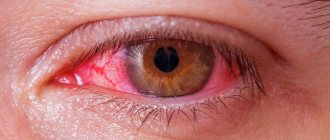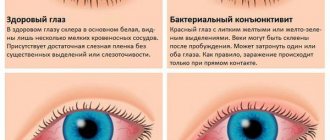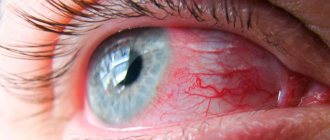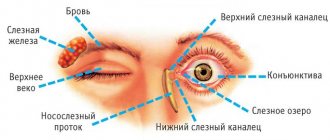Clinical picture of adenoviral conjunctivitis
Adenoviral conjunctivitis is an infectious disease of the eye mucosa, the causative agent of which is adenoviruses 3, 4, 6, 7, 7a, 10, 11:
- Thus, when epidemic outbreaks occur, 3, 7a, 11 are detected;
- with the spread of sporadic diseases - 4, 6, 7, 10.
Signs of the disease
Adenoviral conjunctivitis flares up in spring and autumn. It is common in children's groups. The first symptoms observed in children are:
- headache;
- runny nose;
- a sore throat;
- cough;
- temperature increase;
- chills;
- abdominal pain;
- weakness.
After the primary symptoms inherent in acute respiratory infections, sore throat, and flu, secondary symptoms begin to appear:
- inflammatory process;
- development of conjunctivitis.
Inflammation of the mucous membrane has an incubation period that lasts from 7 to 8 days. Initially, nasopharyngitis develops, accompanied by fever, cough, runny nose, and sore throat. After the next increase in temperature, other symptoms appear. They initially affect one eye, then move to the second. The main signs of inflammation are noted:
- swelling of the eyelids;
- development of photophobia;
- the formation of follicles on the inner region of the mucous membrane of the eyelid;
- redness;
- discharge of clear mucus;
- there is an increase in regional lymph nodes;
- decreased vision (disappears after treatment);
- the sensitivity of the cornea decreases.
Adenoviral conjunctivitis affects children and adults with the progression of respiratory tract diseases (sore throat), as well as viral diseases (measles, rubella, chickenpox).
Treatment of the underlying disease is necessary, and adenoviral conjunctivitis may disappear on its own. It is very important to cure a runny nose, sore throat, cough that occurs with a sore throat, and acute respiratory infections.
At the same time, inflamed mucous membranes are washed with herbal infusions.
Reasons for appearance
The spread of this type of inflammation is carried out by airborne droplets. After infection, damage to the eyes and nasopharynx is noted. Adenoviral conjunctivitis can occur in a preschool, school, or institute during epidemiological outbreaks.
The disease is mainly common in children and middle-aged adults. Its duration is within 1 – 3 weeks. The inflamed mucous membrane hurts, the throat, runny nose and other symptoms also bring a feeling of discomfort.
The causes of infection may also be:
- contact with infected people;
- dirty hands - when coming home a person could scratch or rub his eyes with dirty hands;
- household items previously used by an infected person;
- surgical intervention;
- severe hypothermia;
- eye injury;
- progression of respiratory diseases (flu, sore throat, acute respiratory infections).
Forms of the disease
Catarrhal is characterized by mild inflammatory processes on the mucous membrane. There is redness and some mucus. The disease progresses easily in a fairly short period of time (about a week).
Membranous is quite common. It occurs in 25% of cases. It is characterized by the formation of a thin film, which has a grayish-white color and is easily removed with cotton wool. Sometimes these thin films are firmly attached to the conjunctiva, on which bleeding ulcers form. With such symptoms, experts recommend being examined for the presence of diphtheria.
During recovery, there are no traces of the film on the mucous membrane. Rarely, minor scarring may be observed. Peculiar hemorrhages and infiltrates may appear in the conjunctiva. With complete recovery, nothing remains of these formations; they dissolve.
Follicular is characterized by the appearance of small vesicles, which in rare cases reach large sizes. The eye hurts and irritates the child.
The diagnosis of the disease is determined by a specialist after studying the clinical picture. The disease is also detected by smear and culture results.
Complications
Adenoviral conjunctivitis in children cannot be started. If you have a runny nose, cough, sore throat, accompanied by pain in the eyes, redness and inflammation, you should consult a specialist.
The symptoms are by no means harmless. It is necessary to carry out timely treatment to eliminate the symptoms of sore throat and conjunctivitis.
Otherwise, inflammation of the mucous membrane can cause complications in children and adults such as:
These complications arise due to viral damage to the tissues of the eyeball and cornea. There is cloudiness on the cornea, and a decrease in visual acuity can be observed.
Prevention
Adenoviral conjunctivitis in adults and children is not difficult to cure if treatment is started in a timely manner. The most common prevention methods are:
- wet cleaning in a room with a large team;
- frequent ventilation of the room;
- timely treatment of respiratory tract diseases (sore throat, flu, acute respiratory infections);
- timely isolation of an infected person;
- compliance with personal hygiene rules.
Treatment of mucosal inflammation
How long the treatment of this inflammation in children and adults will last depends on the degree of development of inflammation and the body’s immunity.
Treatment of this inflammation in adults and children involves the use of drops and ointments. Drops such as Albucid (sodium sulfacyl) are very effective. This remedy is considered universal for the treatment of this type of mucosal inflammation. It eliminates both mild and acute conjunctivitis.
Interferon-based drops are also very effective for treating this disease:
- Ophthalmeron. These drops have anti-inflammatory, immunomodulatory, antiviral effects. Doctors recommend instillation 6 - 8 times a day in cases where conjunctivitis is acute. You only need 1-2 drops of the product. For mild inflammation, it is enough to perform the procedure 2 – 3 times a day.
- Aktipol. It is an inducer of endogenous interferon. These drops are characterized by strong antioxidant and regenerating properties. Has a very strong antiviral effect. Recommended dosage is 2 drops. It is necessary to instill the inflamed mucous membrane about 8 times a day. Treatment will last approximately 10 days.
- Poludan. These drops are based on a biosynthetic complex of endogenous interferons and cytokines. Recommended dosage – 1 – 2 drops. It is necessary to treat the inflamed mucous membrane 6 – 8 times a day.
Ointments are also used to treat inflammation in children and adults. They should also be used as prescribed by a doctor. Before applying, it is necessary to rinse the child’s eyes with a special infusion prepared from the following herbs: sage, chamomile, tea leaves. After washing the inflamed eye, drops are instilled.
After completing these procedures, you should wait half an hour and lubricate with ointment. Treatment of mucosal inflammation is possible with the following ointments:
- Tebrofen ointment. It effectively copes with various viral eye diseases. Tebroferon ointment should be applied to the inner edge of the eyelid. Lubrication should be done 3 – 4 times a day.
- Florenal. This ointment is for inflammation of the eye mucosa. It has a strong antiviral effect, inhibits adenoviruses, herpes viruses, and Varicella-zoster virus. It should be applied behind the lower eyelid 2 – 3 times a day. Treatment can last from 10 to 45 days.
To treat conjunctivitis in children, Dr. Komarovsky recommends rinsing the nasal cavity and eyes. For this purpose, a special saline solution is used. The use of such a remedy is very effective if a child has a viral infection. Preparation of the solution is very simple: 1 teaspoon of salt + 1 liter of water.
According to Dr. Komarovsky, any viral conjunctivitis will go away on its own only when the human body develops immunity to the infection. And he will be able to do this only after 5 - 7 days.
According to experts, you should consult a doctor in the following cases:
- child's age up to one year;
- manifestation of redness, photophobia in a child;
- Pain in the eyes;
- the appearance of a bubble in the upper eyelid.
According to the specialist, vision can deteriorate significantly if the child is not provided with timely qualified assistance. Therefore, you should not leave everything to chance. Think about your health, as well as your child's vision.
Alina Odintsova
Source: https://zreniemed.ru/bolezni/konjunktivit/adenovirusnyj-konyunktivit.html
Reasons for appearance
The spread of this type of inflammation is carried out by airborne droplets. After infection, damage to the eyes and nasopharynx is noted. Adenoviral conjunctivitis can occur in a preschool, school, or institute during epidemiological outbreaks.
The disease is mainly common in children and middle-aged adults. Its duration is within 1 – 3 weeks. The inflamed mucous membrane hurts, the throat, runny nose and other symptoms also bring a feeling of discomfort.
The causes of infection may also be:
- contact with infected people;
- dirty hands - when coming home a person could scratch or rub his eyes with dirty hands;
- household items previously used by an infected person;
- surgical intervention;
- severe hypothermia;
- eye injury;
- progression of respiratory diseases (flu, sore throat, acute respiratory infections).
Conjunctivitis with sore throat: possible complications
Conjunctivitis is a common disease among the world's population. It occurs as a result of various reasons and factors.
The conjunctiva is damaged and the affected eye becomes swollen, hyperemic and inflamed. The sclera and eyelids should be transparent. In almost 50% of cases, conjunctivitis is combined with a disease such as tonsillitis.
This combination appears as a result of the penetration of an adenoviral infection into the body.
It behaves unpredictably and is quite severe for the patient. In practice, it is rarely observed when the causative agent is an enterovirus infection or measles.
Infectious mononucleosis at its height also causes pastiness and swelling of the eyelids, as well as damage to the palatine tonsils. Swelling of the eyelids occurs only in children of younger or preschool age.
Therefore, it is always necessary to differentiate conjunctivitis from angina.
Clinical picture
Adenovirus infection causes conjunctivitis and damage to the tonsils (tonsillitis). This disease appears during the period of weather change - autumn and spring. Children get sick more often than adults. The reason for this is that the immune system is not fully formed. The infection affects children who are in schools or kindergartens. People call it “collective disease.”
The first symptoms that may appear are:
- lump in the throat;
- migraine;
- fever;
- decreased performance, weakness;
- catarrhal phenomena;
- a sore throat;
- pain in the abdomen;
- febrile temperature.
After the first signs begin to appear, secondary symptoms follow:
- inflammatory processes;
- damage to the conjunctiva of the eyes;
- general intoxication of the body.
The duration of the incubation period is up to 1 week. At this moment, there is a violation of the mucous membrane and inflammation.
At the very beginning, there is a sharp jump in body temperature to febrile levels, frequent coughing attacks, catarrhal syndrome and sore throat.
The specificity of this pathology is that first there is inflammation of one eye, followed by damage to the other. Therefore, experienced doctors immediately determine what kind of pathology the patient has.
There are important signs for this disease:
- pastiness of the eyelids;
- fear of bright light and sun rays;
- the formation of follicles that are localized in the mucosal area on the inside of the eyelid;
- eye hyperemia;
- the size of the lymph nodes increases;
- temporary decrease in vision, gradually recovers after drug therapy;
- violation of corneal trophism;
- a huge amount of discharge from the eye;
- inability to raise eyelids.
If tonsillitis and conjunctivitis appear, you should immediately take action and consult a doctor. If you do not catch it in time, certain complications may arise, after which it becomes much more difficult to treat the patient. It is imperative to treat the disease itself, and not separately conjunctivitis and sore throat. With general therapy, sore throat and conjunctivitis gradually disappear.
Causes of the disease
A person can become ill through airborne droplets or aerosols. As soon as an adenoviral infection enters the body, the patient immediately develops inflammatory processes in the nasal cavity, tonsils, pharynx and eyes. Most often, this infection occurs in places where large numbers of people gather. For children and teenagers, these are kindergartens and schools.
According to statistics, younger and school-aged children are affected, and adults, to a lesser extent. This pathological condition lasts up to 14-21 days. The symptoms that appear cause discomfort due to a sore throat, burning in the eye and a lot of mucus.
The main causes of conjunctivitis that appears with sore throat are:
- direct contact with a sick infected person;
- unwashed hands;
- surgical intervention;
- household items;
- prolonged and severe hypothermia;
- after any trauma to the visual system;
- reduced immunity and frequent acute respiratory viral infections.
Forms of the disease
If mild symptoms of the disease are observed, then this form is catarrhal. Moderate hyperemia and scanty mucus secretion. This form goes pretty quickly. A person is sick for about 5-7 days and recovers practically without complications.
There is also a membranous form, which is quite common among the population. Occurs in 30% of cases. The name of this form speaks for itself that a film is formed on the conjunctiva.
The color of the film is gray, which can be easily removed with a cotton swab.
In some cases, these films are very tightly attached to the mucous membrane, on which ulcers are formed that tend to bleed.
Source: https://bolvglazah.ru/konyunktivit/konyunktivit-pri-angine.html
Prevention measures
It is difficult to prevent the disease, but careful attention to the child’s health will help to promptly notice the baby’s unhealthy condition. The main thing is to detect conjunctivitis in a child with a runny nose in time and immediately consult a doctor.
The sooner treatment begins, the faster complete recovery will occur. Ignoring the symptoms of conjunctivitis, or believing that everything will “go away on its own” leads to complications that require long-term treatment and constant monitoring by an ENT doctor.
To protect the child from the formation and development of rhinitis in combination with conjunctivitis, parents should take the following measures:
- At a very early age, begin teaching your child basic hygiene rules - wash hands, use only a personal towel and washcloth.
- Consistently and persistently wean off touching your eyes with your fingers.
- Avoid contact with sick children.
- Constantly take care of strengthening the immune system: daily walks, taking the indicated vitamin complex.
- Organize proper nutrition: introduce more vegetables, fruits, dairy products, dietary meat, and fish into the diet.
Exclude:
- fatty, fried foods;
- soda;
- fast food products;
- snacks between main meals.
Prevention will help avoid encountering dangerous infections and preserve the health of the growing body.
Conjunctivitis and sore throat
In itself, an unpleasant disease, sore throat, or tonsillitis, is accompanied by conjunctivitis in half of the cases. These two diseases separately cause a lot of trouble, but together they can lead to serious complications. But if you take timely measures and start the right treatment, you can get rid of the disease in a short time.
The combination of sore throat and conjunctivitis has a common name - adenoviral infection. In ordinary life, it is most often called a “collective disease.” This infection belongs to the ARVI group of diseases.
It is caused by an adenovirus. The disease is accompanied by inflammation of the mucous membranes in the nose, throat, and eyes.
Conjunctivitis and tonsillitis are caused by the same virus, so these diseases are often related.
More often the disease affects children. This is due to the fact that babies have not yet fully developed a strong immune system. Adults are susceptible to infection, usually in the off-season, during weather changes - in autumn and spring. The symptoms of an adenovirus infection are the same as those of a common cold.
The patient feels weak, lethargic, the temperature rises, a runny nose, sore throat and sore throat appear. Further to these signs are added redness and swelling of the eyes, lacrimation, and fear of bright light. This is how incipient conjunctivitis manifests itself.
In this case we are talking about a “collective disease”.
There is no specific treatment for adenovirus infection. The disease is treated symptomatically. For mild forms of the disease, eye drops and nasal solutions, immunomodulating agents and vitamins are used.
Any medications are used only as prescribed by a doctor. In more complex cases, treatment is carried out in a hospital.
As a rule, in the hospital, drugs are administered intravenously to reduce intoxication of the body, in some cases antibacterial agents.
Sore throat and conjunctivitis in a child
Children are more susceptible to adenovirus infection than adults. The virus is transmitted by airborne droplets. Therefore, very often children bring illness from kindergarten or school.
In case of illness, the time from contact with the patient to the appearance of the first signs of illness can be from 5 to 12 days. Symptoms of the disease in children are similar to those in adults. The child's temperature rises, there is a loss of strength, a runny nose, decreased appetite, and headaches.
Conjunctivitis with sore throat appears first in one eye, and then moves to the second.
Symptoms include eyelashes stuck together after sleep and swollen upper eyelids. When the disease develops against the background of a cold, it is most likely viral conjunctivitis. In this case, you need to carefully wipe your eyes with a cotton pad soaked in tea leaves or warm boiled water.
There are several types of eye damage caused by adenovirus infection. The most harmless form is catarrhal conjunctivitis. The disease is accompanied by slight redness of the whites of the eyes. There is no pain or burning in this case. Proper treatment eliminates symptoms within a week.
When small blisters appear on the mucous membranes of the eyes or on the eyelids, this is a follicular type of conjunctivitis. This form is accompanied by fever, severe runny nose and sore throat.
The most common form of conjunctivitis in children is the membranous form of conjunctivitis. The disease is not difficult to recognize. With this type of inflammation, the eyeball is covered with a white dense film.
A high temperature of up to 40-41 degrees can last from three to seven days.
Treatment of adenovirus infection in children
Conjunctivitis and sore throat are treated with several means at once. Take anti-inflammatory and antipyretic drugs, ointments, and wash the mucous membranes with herbal infusions.
The child's eyes are regularly washed with a solution of furatsilin or a slightly pink solution of potassium permanganate. A weak tea brew will also work. 5% tebrofen ointment is placed behind the eyelids. The procedure is repeated 3-4 times a day.
During the day, interferon is instilled into the eyes 4-6 times.
If the child has a fever, children's antipyretic drugs (paracetamol, ibuprofen, nurofen and others) are taken. During the illness, the child is prescribed bed rest. Until complete recovery, plenty of hot drinks, light meals, large amounts of plant foods and dairy products are recommended. Therapy is aimed at treating specific manifestations of the disease.
Standard medications are used to treat angina. Along with them, traditional medicine recipes are used. This will help relieve a sore throat using various types of gargles. Soda-salt solution has an antiseptic effect.
To prepare it, you need to dissolve a teaspoon of salt and baking soda in half a liter of warm boiled water. Chamomile flowers are a good natural antibiotic and antiseptic. An infusion of this plant will help relieve inflammation faster.
A teaspoon of chamomile is poured with 300 grams of boiling water and covered with a lid. The product is allowed to brew for about an hour. Then the liquid is filtered and gargled. The infusion is stored in the refrigerator and heated before rinsing.
You can add a tablespoon of sea buckthorn oil to the solution; it has an analgesic effect.
The most common folk remedy for the treatment of sore throat is milk with honey. Dissolve a tablespoon of honey in a glass of milk. You can add a piece of butter to the mug. This drink is good for relieving a sore throat.
It is important to note that before consuming honey, you must make sure that the patient is not allergic to it. Before starting home treatment for conjunctivitis and sore throat, you should consult a doctor. You need to discuss all treatment methods for both conjunctivitis and sore throat with a specialist.
Improper self-medication can lead to serious consequences, especially when it comes to the health of a child.
Source: https://ormira.ru/konjunktivit-i-bolit-gorlo/
Treatment of “collective disease” in adults
If conjunctivitis is not advanced, it can be cured at home. Cool boric water is suitable for wiping your eyes. Drops are placed behind the eyelid and can be purchased at a pharmacy without a prescription. After the solution enters, the eyes are kept closed for several seconds. During the treatment of conjunctivitis, you should stop using cosmetics and wearing contact lenses. During illness, you should not overstrain your eyes; it is better to stop reading, watching TV and working at the computer for a while. Lotions are effective in the treatment of conjunctivitis and sore throat. Once a day, you can apply cotton pads or gauze soaked in dill juice to your eyelids for 15 minutes. Rosehip infusion is used in the same way. Two tablespoons of berries are poured into a glass of boiling water and infused. The strained solution is applied to the eyes. Herbal tinctures are effective - chamomile, sage, cornflower. Compresses are also made from aloe juice. It is diluted with cold boiled water in a one to one ratio. Soak gauze in the resulting liquid and keep it on the eyelids for 5-10 minutes 1-2 times a day. If there is no improvement 2-3 days after home treatment, you should consult a doctor.
At the same time, treatment of sore throat is carried out. In the fight against this disease, if it has not become serious, traditional methods are effective. Treatment of conjunctivitis with angina lasts on average from 10 to 12 days, and this is if the therapy is carried out correctly. Recurrence of the disease is rare, however, if the disease was not completely cured, there is a high probability of its return. In general, complex treatment in most cases gives a positive result. Despite the proven effectiveness of the listed remedies, treatment of conjunctivitis should be carried out in consultation with a doctor.
Adenovirus infection
- Increased body temperature (up to 38-39 degrees, duration usually 5-7 days).
- Lethargy, weakness, general malaise, chills.
- Runny nose with mucous discharge.
- Nasal congestion.
- A sore throat.
- Sore throat.
- Coughing.
- Redness, swelling of the mucous membrane of the eyes (conjunctiva).
- Discomfort, burning, itching of the eyes.
- Tearing.
- Nausea, vomiting.
- Enlarged tonsils, cervical, submandibular, axillary lymph nodes.
The classic manifestation of adenovirus infection is a combination of four main symptoms: rhinitis (inflammation of the nasal mucosa, runny nose) + pharyngitis (inflammation of the pharynx, pharynx - sore throat) + conjunctivitis (inflammation of the conjunctiva (mucous membrane of the eye) - redness, swelling of the mucous membrane of the eyes, lacrimation) + fever (increased body temperature).
From 1-14 days (on average 5-7 days).
Acute respiratory disease is accompanied by various damage to organs and body systems:
- rhinopharyngitis (damage to the nasal passages and pharynx);
- rhinopharyngotonsillitis (damage to the nasal passages, pharynx and palatine tonsils);
- nasopharyngobronchitis (damage to the nasal passages, pharynx, bronchi);
- pharyngoconjunctivitis (pharyngoconjunctival fever) - damage to the pharynx in combination with damage to the mucous membrane of the eyes (conjunctiva);
- conjunctivitis and keratoconjunctivitis (damage to the mucous membrane of the eyes and cornea (transparent membrane) of the eye);
- pneumonia (lung damage);
- Another combination of organ damage is also possible.
Pharyngo-conjunctival fever by :
- increased body temperature;
- pharyngitis (inflammation of the mucous and lymphoid tissue of the pharynx);
- inflammation of the mucous membrane of the eye (accompanied by a sensation of a foreign body in the eye, burning);
- a whitish film may form on the surface of the eye and a white-yellow discharge in the corners of the eye;
- frequent dry cough, which turns into a wet cough with sputum on the 3-4th day.
Epidemic keratoconjunctivitis is accompanied by:
- burning sensation in the eyes;
- lacrimation;
- clouding of the cornea;
- erosion (destruction) of the cornea up to loss of vision;
- gastroenteritis (damage to the mucous membrane of the gastrointestinal tract, accompanied by frequent bowel movements up to 5 times a day);
- sharp pain in the abdomen in the navel area.
Adenoviral atypical pneumonia is accompanied by pneumonia caused by the virus itself, and not as a result of the addition of a secondary bacterial infection, develops against a background of severely reduced immunity, and is characterized by a severe course.
- Routes of transmission: sick person;
- virus carrier (the virus is contained in the human body, is released into the external environment, but does not cause symptoms of the disease, but at the same time infects other people).
- Source of infection: airborne (the virus is released from the body of a sick person when coughing and sneezing and spreads through the air);
- transmission is possible through the fecal-oral route (the virus enters the body through contaminated food or hands).
- The disease occurs year-round, but the highest incidence is observed in the autumn-winter period (this is facilitated by a decrease in immunity in people due to frequent cooling of the body and environmental conditions that are optimal for the reproduction of the virus (temperature, air humidity)).
LookMedBook reminds you that this material is posted for informational purposes only and does not replace medical advice!
- The therapist will help in treating the disease
Make an appointment with a therapist
- Analysis of patient complaints: a characteristic combination of increased body temperature, runny nose, sore throat, redness of the mucous membrane of the eyes.
- Often in the anamnesis there are indications of contact with a patient (cold), outbreaks of infection in the team (for example, a large number of children with “colds” in the class).
- Examination of the patient: nasal breathing is difficult, mucous discharge from the nose; in the pharynx (throat) there is hyperemia (redness), the conjunctiva is swollen, red, etc.
- To identify the pathogen and confirm the diagnosis, ELISA (immunofluorescence analysis) and PCR (polymerase chain reaction) of a nasal swab are used.
- In most cases, studies to identify the pathogen (rhinovirus) are not carried out due to its mild course. The disease occurs with a general diagnosis - ARVI.
- It is also possible to consult an ophthalmologist.
There is no specific therapy for adenoviral infection; treatment is symptomatic. In mild cases the following are prescribed:
- eye drops, ointments (for eye damage) - strictly as prescribed by the doctor;
- nasal drops (vasoconstrictor, oil, etc.);
- immunomodulatory drugs - strictly as prescribed by the doctor;
- vitamin C (and products containing it: rosehip decoction, cranberry compote, etc.);
- drinking plenty of water;
- chamomile decoction.
In severe cases, treatment is carried out in a hospital. In addition to the above, they carry out:
- infusion therapy - solutions are administered intravenously to reduce intoxication of the body;
- antibacterial drugs (if a bacterial infection is attached).
In most cases, adenovirus infection occurs without complications and has no consequences.
The most common complications are:
- pneumonia (pneumonia);
- angina;
- sinusitis (inflammation of the paranasal sinuses);
- otitis (inflammation in the ear cavity);
- swelling, necrosis (death of tissue areas) of the walls of the bronchi and alveoli;
- damage to the liver, kidneys, spleen;
- exacerbation of other existing chronic diseases.
- Avoid visiting crowded places (theaters, shops, etc.) during an infection epidemic.
- If one of the family members becomes ill with an adenovirus infection, he must be isolated and given a separate towel and dishes. The patient must wear a medical mask.
- Hardening the body (carrying out procedures aimed at increasing the body’s resistance to the effects of low (cooling) and high (overheating) temperatures. For example, dousing with cold water).
- During the period of rising viral incidence (ARVI), take multivitamin preparations or vitamin C.
- Avoid hypothermia.
- Taking interferon.
- Putting oxolinic ointment in the nose.
- Strict adherence to personal hygiene rules (regular hand washing after contact with objects on which the virus could remain).
- Disinfection of premises.
Source: https://lookmedbook.ru/disease/adenovirusnaya-infekciya
Conjunctivitis during colds: proper treatment and relationship
Acute infectious diseases can cause complications in the form of conjunctivitis. This occurs due to damage to the conjunctiva by viruses or activation of the body’s own pathogenic microflora against the background of weakened immunity. It is important to start treatment of conjunctivitis during ARVI in time, eliminate the cause of the disease and prevent the situation from worsening.
Etiology of the disease
Colds are diseases that arise as a result of hypothermia. When a person is cold, his body is more susceptible to pathogenic microflora. The main cause of such ailments are viruses. In addition to the respiratory system, they can affect the organs of vision. In this case, conjunctivitis joins a sore throat and runny nose.
Inflammation of the conjunctiva accompanies the following diseases with varying frequency:
- Acute respiratory viral infections can cause damage to the eye mucosa. There is a possibility of simultaneous infection of the respiratory and visual organs, or a subsequent complication of a cold. The main symptoms of ARVI include redness and swelling of the conjunctiva, itching, and tear discharge.
- Adenovirus infection - often affects both the eyes and throat. It causes fever, red throat and conjunctivitis. Doctors diagnose adenopharyngoconjunctival fever.
- Sore throat and conjunctivitis are rarely combined. Inflammation of the mucous membrane of the eyes can occur if the tonsils are infected by an adenovirus. After a sore throat, complications occur in the heart, joints, and pharynx, but conjunctivitis is not on the list of risks.
- Conjunctivitis with influenza is a dangerous condition that can be complicated by neuritis and keratitis. The inflammatory process develops during or after illness. When the cornea becomes infected, eye flu is diagnosed.
Most often, conjunctivitis is combined with inflammation of the upper respiratory tract. The appearance of its symptoms requires contacting an ophthalmologist and carrying out special local treatment.
Can conjunctivitis be caused by a runny nose?
The close proximity of the eyes and nose makes the transition of infection from one organ to another quite rapid. Conjunctivitis that develops from sinusitis is especially dangerous. Bacteria from the purulent contents of the maxillary sinuses settle in the fatty tissue of the orbit and can lead to an abscess.
Varieties
Conjunctivitis against the background of acute respiratory viral infections and similar diseases is treated by a therapist (children - pediatrician) together with an ophthalmologist. Differential diagnostics are carried out to determine the pathogen. The choice of medications for treatment depends on this. The following types of inflammation of the mucous membrane are distinguished according to the type of pathogen:
- Bacterial conjunctivitis is most often a consequence of ARVI. Immunity decreases, which encourages the activation of opportunistic bacteria - staphylococci and streptococci. From the outside, pneumococci and Haemophilus influenzae can enter the eyes.
- Adenoviral - if your throat hurts badly and conjunctivitis has developed, then the causative agent of the disease is an adenovirus. First, the disease affects one eye, and after a couple of days - the second.
- Herpetic - the herpes simplex virus, after entering the human body, is in a dormant state. A cold activates it and a rash appears. It is usually localized on the lips, but if hygiene rules are not followed, it can affect the eyes.
Most symptoms are the same for all types of conjunctivitis. But there are signs by which they can be distinguished, which makes the diagnosis easier.
Drug therapy
Treatment is aimed at eliminating the cause of the disease and alleviating symptoms. Albucid is a universal drug for infectious conjunctivitis of any origin. These sulfacetamide eye drops stop the growth of germs. Use up to 6 times a day, 2-3 drops in each eye. Albucid can be administered even to newborns.
Based on the diagnosis, the following medications are prescribed:
- Tetracycline ointment is a broad-spectrum antibacterial agent. It needs to be placed behind the lower eyelid 2 to 5 times a day. The drug has a number of side effects.
- Poludan - prescribed for inflammation of viral etiology. The medicine stimulates the production of interferon. It is instilled into the conjunctival sac or injected under the eyeball. The dosage and duration of treatment is determined depending on the course of the disease.
- Oftalmoferon - drops with antiviral and antibacterial effects. The drug relieves pain, reduces inflammation, and helps restore damaged tissue. Instill 1-2 drops 2 to 8 times a day until complete recovery.
- Zovirax is an antiherpes ointment based on acyclovir. It is laid at intervals of 4 hours maximum 5 times a day.
Medicines are taken only after consultation with a doctor, following the recommended dosage. Self-medication can lead to serious health consequences.
Traditional medicine
Traditional methods cannot provide complete treatment, but it can be supplemented. The following remedies are most effective:
- Aloe will help overcome cough and conjunctivitis. A mixture of peeled, crushed leaves of the plant with honey (1:1) is taken in a teaspoon 3-4 times a day. It softens the throat and relieves inflammation. Eyes are wiped with aloe juice several times a day. As a result, the itching subsides and the amount of discharge decreases.
- Essential oils relieve the condition of an adult or child with a runny nose and conjunctivitis. A couple of drops are added to the water for the aroma lamp, or an open bottle of oil is left in the room. Eucalyptus, mint, and tea tree are especially effective.
- Cornflower, chamomile, oak bark, and birch buds have disinfectant properties. To prepare a decoction, you need 0.25 cups of boiling water per tablespoon of dry raw materials. The finished infusion is used to wash the eyes for a maximum of 24 hours, then it is replaced with fresh one.
Features of the course of the disease and treatment in children
The smaller the child, the faster he develops an infectious disease. The clinical picture is more pronounced than in adults. At the first signs of conjunctivitis against the background of ARVI in a child, you should immediately contact a specialist and treat only with the drugs prescribed by him.
During illness, you need to especially carefully monitor the patient’s nails and cut them short. Itching in the eyes forces you to constantly rub them; long nails can lead to injury and worsening the condition. For children under one year of age, drops are placed into the eyes with a pipette with a rounded end.
You can attend kindergarten or school only after recovery.
How to prevent cold conjunctivitis
To prevent colds, it is important to strengthen the immune system, harden yourself, and eat rationally. In the midst of the spread of viral infections, it is advisable to visit crowded places less often and spend more time in the fresh air. If the disease has already affected the respiratory tract, the following preventive measures will help avoid spreading to the eyes:
- When coughing, cover your mouth with your elbow, not your palm;
- Wash hands frequently;
- Do not touch your eyes with your hands;
- If necessary, remove debris from the eye using a clean napkin or handkerchief.
Regular wet cleaning of the house, change of bed linen and towels, and frequent ventilation are required. It is recommended to periodically wash and replace cosmetic brushes and sponges.
Conjunctivitis during colds in adults and children occurs quite often. The disease lasts from 1 to 3 weeks. Cough, conjunctivitis, and runny nose cause significant discomfort to the patient. Preventive measures and timely treatment of infections in the respiratory tract will help prevent the disease.
Source: https://GlazaLik.ru/bolezni-glaz/konyunktivit/konyunktivit-pri-prostude-pravilnoe-lechenie-i-vzaimosvyaz/
How is diagnosis carried out?
To determine the inflammatory factor, bacteriological culture of secretions from the nose and eyes is carried out.
Conjunctivitis and snot are diagnosed by an ophthalmologist and ENT specialist. To determine the causes of inflammation of the conjunctiva during a runny nose, the following diagnostic procedures are performed:
- allergy testing;
- taking a smear for cytological analysis;
- bacterial culture of purulent discharge from the eye and nose.










